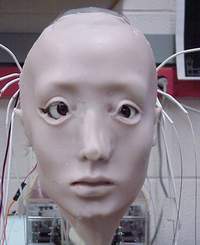Scientists work on laws for robots to avoid possible war with artificial intelligence
Japan's Ministry of Economy, Trade and Industry is working on a new set of safety guidelines for next-generation robots. This set of regulations would constitute a first attempt at a formal version of the first of Asimov's science-fictional Laws of Robotics, or at least the portion that states that humans shall not be harmed by robots.

The first law of robotics, as set forth in 1940 by writer Isaac Asimov, states: A robot may not injure a human being, or, through inaction, allow a human being to come to harm.
Japan's ministry guidelines will require manufacturers to install a sufficient number of sensors to keep robots from running into people. Lighter or softer materials will be preferred, to further prevent injury.
Emergency shut-off buttons will also be required. Science fiction heroes in stories and movies have spent an inordinate amount of time trying to find the shut-off button for various out-of-control machines, so there is a hope that these buttons will be prominently placed for easy access by concerned humans.
People in Japan are particularly concerned about this problem, due to the accelerating efforts to create robots that will address the coming labor shortage in Japan's elder care industry.
Robot nannies?
Philip K. Dick wrote about a robot named Nanny in a 1952 short story with the same name. Here's a bot built for babysitting.
Nanny was built in the shape of a sphere, a large metal sphere, flattened on the bottom. Her surface had been sprayed with a dull green enamel, which had become chipped and gouged through wear. There was not much visible in addition to the eye stalks. The treads could not be seen. On each side of the hull was the outline of a door. From these the magnetic grapples came, when they were needed. The front of the hull came to a point, and there the metal was reinforced. The extra plates welded both fore and aft made her look almost like a weapon of war...
InTouch Companion: Medical Rounding Robot?
InTouch Health is now leasing a remote-controlled medical telepresence robot called The Companion to hospitals and nursing homes nationwide. The 200 pound robots stand about five feet tall and have computer screens for "heads"; they are controlled remotely by physicians with a wireless broadband Internet connection, the right software and a joystick control.
The purpose of the "rounding robots" is to allow physicians who admit patients to widely separated medical centers to be able to round (that is, visit or provide a consultation to) their patients without having to waste hours of travel time in their cars. Patients can see their own doctor and speak with him or her in real time; the physicians can also see and hear their patients.
The robot can travel about 2 miles per hour; a safety mechanism uses infrared warning sensors to keep the robot from bumping into people and objects. InTouch leases them for about $3,000 per month, which includes hardware, software and support.
RI-MAN And Roujin-Z Robots: Elder Care Fact And Fiction?
RI-MAN, a five-foot tall humanoid robot, is the latest in a series of prototype robots intended to assist with one of Japan's most pressing problems; the care of its older citizens. RI-MAN can see and follow movement, it can hear and process commands - it can even smell odors that might be relevant to health care.
In the demonstration, a researcher orders RI-MAN to pick up a woman. "The woman on the bed?" asks the robot. "Yes," says the researcher. The robot comes closer and gently picks up the woman (actually a life-like doll weighing 25 pounds) by carefully supporting the back and legs. "I succeeded in holding her," the robot says at the conclusion of the exercise.
Japan is expected to have one of the largest populations of senior citizens, at the same time that its birthrate is dropping. By the year 2020, Japan expects that about twenty-five percent of its population will be over sixty-five years of age.
Source: livescience.com
Prepared by Alexander Timoshik
Pravda.ru
Subscribe to Pravda.Ru Telegram channel, Facebook, RSS!




